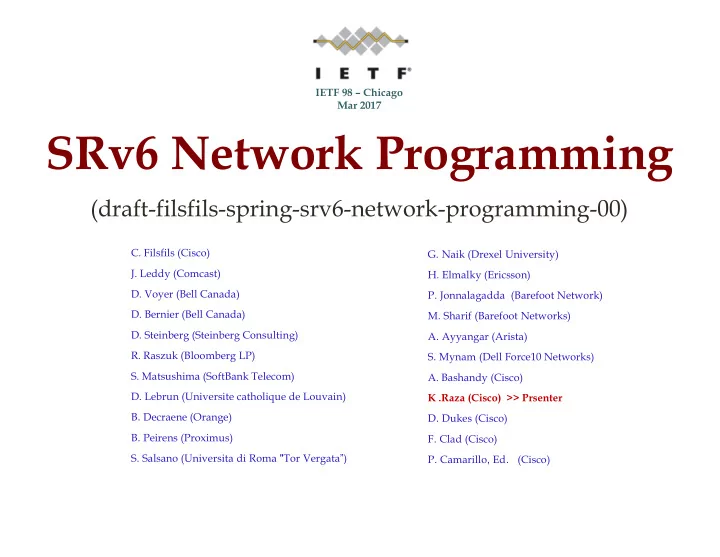

IETF 98 – Chicago Mar 2017 SRv6 Network Programming (draft-filsfils-spring-srv6-network-programming-00) C. Filsfils (Cisco) G . Naik (Drexel University) J. Leddy (Comcast) H. Elmalky (Ericsson) D. Voyer (Bell Canada) P . Jonnalagadda (Barefoot Network) D. Bernier (Bell Canada) M . Sharif (Barefoot Networks) D. Steinberg (Steinberg Consulting) A . Ayyangar (Arista) R. Raszuk (Bloomberg LP) S . Mynam (Dell Force10 Networks) S. Matsushima (SoftBank Telecom) A. Bashandy (Cisco) D. Lebrun (Universite catholique de Louvain) K .Raza (Cisco) >> Prsenter B . Decraene (Orange) D . Dukes (Cisco) B . Peirens (Proximus) F . Clad (Cisco) S . Salsano (Universita di Roma " Tor Vergata ” ) P . Camarillo , Ed . (Cisco)
Introduction “SRv6 network programming” refers to the capability for an application to encode any complex program as a set of individual functions distributed through the SRv6 network.
Introduction (2) This draft is the “key” SRv6 document that describes SRv6 Ø network programming concepts, its various functions, and their use cases: Local-SID Functions, Transit Behavior § Control Plane § Counters, Security § Use case illustrations § Status: Ø Larger community support (from vendors and operators) § Multiple interoperable implementations § Open Software Projects: http://www.segment-routing.net/open- • software/ (VPP 17.04 and Linux Kernel 4.10)
Local SID A local SID has a specific instruction bound to it. Ø An SRv6-capable node N maintains a table containing all the Ø local SRv6 segments explicitly instantiated at node N. N is the parent node for these SIDs. § A local SID of N could be routed to N but it does not have to Ø be. Most often, it is routed to N via a shorter-mask prefix.
Local SID (2) SRv6 local SID is represented as LOC:FUNCT Ø LOC is the L most significant bits § FUNCT is the (128-L) least significant bits. § L is called the locator length and is flexible: § no assumption on size/length • Most often the LOC part of the SID is routable and leads to Ø the node which owns that SID. The FUNCT part of the SID is an opaque identification of a Ø local function bound to the SID. Hence the name SRv6 “Local” SID. LOC:FUNCT:ARGS if function requires argument(s) §
Local SID Functions This draft defines a set of well-known functions that can be Ø associated with a local SID. For each function, packet processing algorithm is also § documented at a high level
Local SID Functions (2) Name Forwarding Use case End * Lookup Prefix SID End.X * L3 Xconnect Adj SID End.T * Lookup in table T Multi-table operation in the core End.DT6 Decap and IPv6 table T lookup IPv6 L3VPN - Per-VRF End.DT4 Decap and IPv4 table T lookup IPv4 L3VPN - Per-VRF End.DX6 Decap and IPv6 Xconn IPv6 L3VPN - Per-CE End.DX4 Decap and IPv4 Xconn IPv4 L3VPN - Per-CE End.DX2 Decap and L2 Xconn L2VPN *: With variants
Local SID Functions (3) Name Forwarding Use case End.B6 SRv6 policy Binding SID End.B6.Encaps SRv6 policy (with encap) Binding SID End.BM SR-MPLS policy Binding SID End.S Search of a target (Locally ICN forward or END behavior) End.AS Remove Outer IPv6 header Service Chaining via and SRH, forward to an SR-unaware App interface End.AM Update Outer IPv6 header Service Chaining via DA with LAST SID and an SR-unaware App forward to interface (with masquerade)
SRH Pop “SRH Pop” refers to removal (pop) of the “top” SRH in a received Ø SRv6 packet at an endpoint. We define SRH popping for the following functions: Ø End, End.X, and End.T § Flavors: Ø Two variants: § Ultimate Segment Pop (USP) : SRH Popped at last segment • Penultimate Segment Pop (PSP): SRH Popped at penultimate segment • For each of the above End functions, these variants can be enabled § or disabled either individually or together.
Transit Behaviors Transit node: A node that receives an IPv6/SRv6 packet Ø whose DA is neither local address nor local SID Namen Behavior T Pure Transit T.Insert Insert an SRv6 policy T.Encaps Encap an SRv6 policy T.Encaps.L2 Encap an SRv6 policy on L2 frame
Control Plane The following table summarizes which SID would be signaled Ø in which signaling protocol Name IGP BGP-IP/VPN BGP-LS End X X End.X X X End.T X X End.DT6 X X End.DT4 X X End.DX6 X X End.DX4 X X End.DX2 X X End.BM X End.S X End.AS X End.AM X T X T.Insert X T.Encaps X T.Encaps.L2 X
Counters and Security Counters: Ø Local SID - Matched and processed correctly/incorrectly § SR policy – Steered into and processed correctly/incorrectly § Security: Ø “How a domain of trust can operate SRv6-based services for § internal traffic while preventing any external traffic from accessing these internal SRv6-based services.” Some mechanisms: § ACL on the external interface to drop any traffic with SA or DA in • the internal SID space ACL to prevent access to local SIDs from outside the operator's • infrastructure An SRv6 router MUST only implement the End behavior on a local • IPv6 address if that address has been explicitly enabled as a segment (local SID) Support Unicast-RPF on source address on external interface •
Use Case Illustrations Basic Security Ø SR-L3VPN Ø SR-L2VPN-VPWS Ø SRTE for Underlay SLAs Ø Policy @ ingress PE § Policy @ mid § End-to-end SRTE policy Ø TI-LFA Ø SRTE for Service Chaining Ø
Draft: Next Steps Seeking WG input and feedback Ø Comments and suggestions are welcomed !!! Ø
Recommend
More recommend